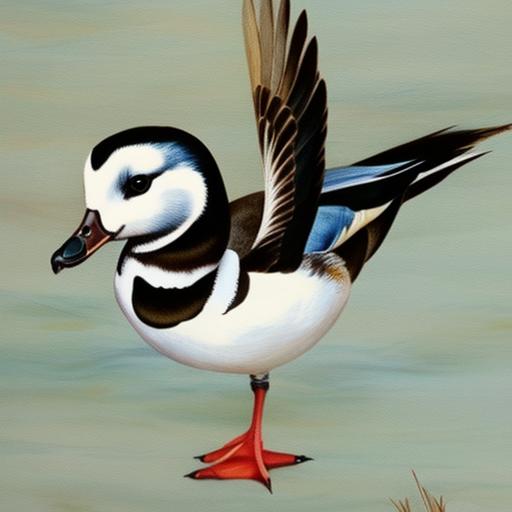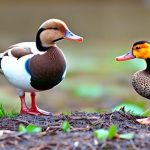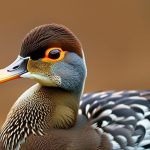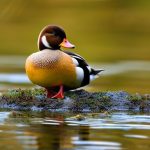The long-tailed duck, also known as the oldsquaw, is a strikingly beautiful species of sea duck that is found in the northern parts of North America, Europe, and Asia. These ducks are known for their unique breeding plumage, which is a sight to behold. Long-tailed ducks are medium-sized ducks with long, slender tails that give them their distinctive appearance. They are known for their striking black and white plumage, with the males sporting a bold black and white pattern on their heads and necks, while the females have a more subdued brown and white coloring. Long-tailed ducks are known for their graceful and agile swimming abilities, and they are often found in coastal waters, where they dive for their food, which consists mainly of mollusks, crustaceans, and small fish.
Key Takeaways
- Long Tailed Ducks are a species of sea duck known for their striking breeding plumage.
- The breeding plumage of Long Tailed Ducks is characterized by a mix of black, white, and gray feathers, with elongated central tail feathers.
- Breeding plumage plays a crucial role in attracting mates and establishing breeding territories for Long Tailed Ducks.
- During the breeding season, Long Tailed Ducks exhibit changes in behavior such as courtship displays and territorial aggression.
- Environmental factors such as food availability and habitat quality can impact the development and maintenance of Long Tailed Duck breeding plumage.
- Conservation efforts are underway to protect Long Tailed Duck breeding plumage, including habitat preservation and monitoring of breeding populations.
- Long Tailed Duck breeding plumage is not only visually stunning, but also plays a vital role in the species’ reproductive success and overall ecological significance.
Description of Long Tailed Duck Breeding Plumage
During the breeding season, male long-tailed ducks undergo a remarkable transformation in their plumage. Their breeding plumage is truly a sight to behold, with the males developing a striking black and white pattern on their heads and necks. The head is predominantly black with a large white patch on the side of the face, while the neck is adorned with bold black and white stripes. The rest of the body remains mostly unchanged, with the back and wings retaining their characteristic black and white coloring. The females, on the other hand, also undergo a change in their plumage during the breeding season, although it is not as dramatic as that of the males. Their breeding plumage consists of a more subdued brown and white coloring, with the brown becoming more pronounced on the head and neck.
The breeding plumage of long-tailed ducks is not only visually stunning but also serves a practical purpose. The bold black and white pattern on the males’ heads and necks serves as a signal to attract potential mates during the breeding season. This striking plumage is a key component of the courtship display, as males use it to attract females and establish their dominance within the breeding population. The females, in turn, use their more subdued breeding plumage to assess the quality of potential mates and select the most suitable partner for breeding. This process of mate selection based on breeding plumage is crucial for the long-term survival of the species, as it ensures that only the fittest individuals are chosen to pass on their genes to the next generation.
Importance of Breeding Plumage in Long Tailed Duck Mating
The breeding plumage of long-tailed ducks plays a crucial role in their mating behavior and reproductive success. During the breeding season, males use their striking black and white plumage to attract females and establish their dominance within the breeding population. They engage in elaborate courtship displays, which often involve displaying their breeding plumage to potential mates while vocalizing and performing intricate swimming maneuvers. The females, in turn, use their more subdued breeding plumage to assess the quality of potential mates and select the most suitable partner for breeding.
The importance of breeding plumage in long-tailed duck mating cannot be overstated. It is a key component of the species’ reproductive strategy, as it allows individuals to assess the genetic quality of potential mates and select partners that will produce healthy offspring. This process of mate selection based on breeding plumage helps to ensure that only the fittest individuals are chosen to pass on their genes to the next generation, thereby contributing to the long-term survival of the species.
Changes in Behavior During Breeding Season
During the breeding season, long-tailed ducks undergo significant changes in their behavior as they focus on courtship, mating, and raising their young. Males become more aggressive and territorial as they compete for access to females and establish their dominance within the breeding population. They engage in elaborate courtship displays, which often involve displaying their breeding plumage to potential mates while vocalizing and performing intricate swimming maneuvers. Females become more selective in choosing their mates, using their subdued breeding plumage to assess the genetic quality of potential partners.
The changes in behavior during the breeding season are driven by the need to ensure reproductive success and the survival of offspring. Long-tailed ducks invest a significant amount of time and energy into courtship and mating rituals to increase their chances of producing healthy offspring. This includes engaging in complex social interactions, defending territories, and selecting suitable partners based on their breeding plumage. These behavioral changes are crucial for the long-term survival of the species, as they contribute to successful reproduction and the continuation of healthy genetic lineages.
Environmental Factors Affecting Long Tailed Duck Breeding Plumage
Several environmental factors can affect the development and display of long-tailed duck breeding plumage. One of the most significant factors is habitat quality, as long-tailed ducks rely on healthy coastal waters for feeding and courtship displays during the breeding season. Pollution, habitat destruction, and climate change can all have a negative impact on the availability of suitable breeding grounds for long-tailed ducks, which can in turn affect the development and display of their breeding plumage.
Another environmental factor that can affect long-tailed duck breeding plumage is food availability. Long-tailed ducks primarily feed on mollusks, crustaceans, and small fish, which are dependent on healthy marine ecosystems for their survival. Changes in food availability due to overfishing, pollution, or habitat destruction can impact the overall health and condition of long-tailed ducks, which can in turn affect the development and display of their breeding plumage.
Conservation Efforts to Protect Long Tailed Duck Breeding Plumage
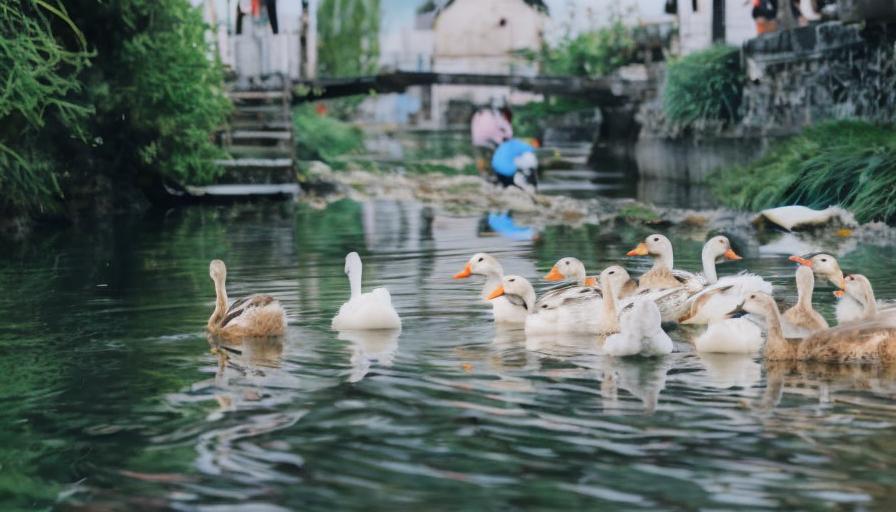
Conservation efforts aimed at protecting long-tailed duck breeding plumage focus on addressing the environmental factors that can negatively impact the species’ reproductive success. This includes initiatives to protect and restore coastal habitats, reduce pollution in marine ecosystems, and mitigate the effects of climate change on long-tailed duck populations. Conservation organizations also work to raise awareness about the importance of breeding plumage in long-tailed duck mating behavior and advocate for policies that support the protection of this unique species.
In addition to habitat conservation efforts, conservation organizations also work to monitor long-tailed duck populations and conduct research to better understand the factors that affect their breeding plumage. This research helps to inform conservation strategies and management plans aimed at protecting long-tailed ducks and ensuring their long-term survival.
The Beauty and Significance of Long Tailed Duck Breeding Plumage
In conclusion, long-tailed duck breeding plumage is not only visually stunning but also plays a crucial role in the species’ mating behavior and reproductive success. The striking black and white pattern on the males’ heads and necks serves as a signal to attract potential mates during the breeding season, while females use their more subdued breeding plumage to assess the genetic quality of potential partners. The changes in behavior during the breeding season are driven by the need to ensure reproductive success and the survival of offspring.
Environmental factors such as habitat quality and food availability can affect the development and display of long-tailed duck breeding plumage, making conservation efforts crucial for protecting this unique species. Conservation organizations play a key role in addressing these environmental factors and advocating for policies that support the protection of long-tailed ducks. By working together to protect long-tailed duck breeding plumage, we can ensure that this beautiful species continues to thrive for generations to come.
Long-tailed ducks are known for their striking breeding plumage, which is a sight to behold. If you’re interested in learning more about the fascinating world of bird breeding, you might want to check out an article on Poultry Wizard that discusses the process of hatching chicken eggs naturally. Understanding the intricacies of breeding and hatching can provide valuable insights into the care and management of various bird species. You can read the article here.
FAQs
What is the breeding plumage of long-tailed ducks?
Long-tailed ducks have a striking breeding plumage, with the males displaying a black and white pattern on their bodies, a black head with a white cheek patch, and a long, pointed tail. The females have a more subdued appearance, with a mottled brown and white pattern.
When do long-tailed ducks acquire their breeding plumage?
Long-tailed ducks acquire their breeding plumage in the spring, as they prepare for the breeding season. This plumage is used for courtship displays and to attract mates.
Where do long-tailed ducks breed?
Long-tailed ducks breed in the Arctic tundra, typically in areas with freshwater lakes and ponds. They build their nests on the ground, often near the water’s edge.
How long does the breeding plumage of long-tailed ducks last?
The breeding plumage of long-tailed ducks typically lasts throughout the breeding season, which can range from late spring to early summer, depending on the location.
Do long-tailed ducks molt out of their breeding plumage?
Yes, after the breeding season, long-tailed ducks molt out of their breeding plumage and acquire a more subdued, non-breeding plumage. This molt usually occurs in late summer or early fall.
Meet Walter, the feathered-friend fanatic of Florida! Nestled in the sunshine state, Walter struts through life with his feathered companions, clucking his way to happiness. With a coop that’s fancier than a five-star hotel, he’s the Don Juan of the chicken world. When he’s not teaching his hens to do the cha-cha, you’ll find him in a heated debate with his prized rooster, Sir Clucks-a-Lot. Walter’s poultry passion is no yolk; he’s the sunny-side-up guy you never knew you needed in your flock of friends!

